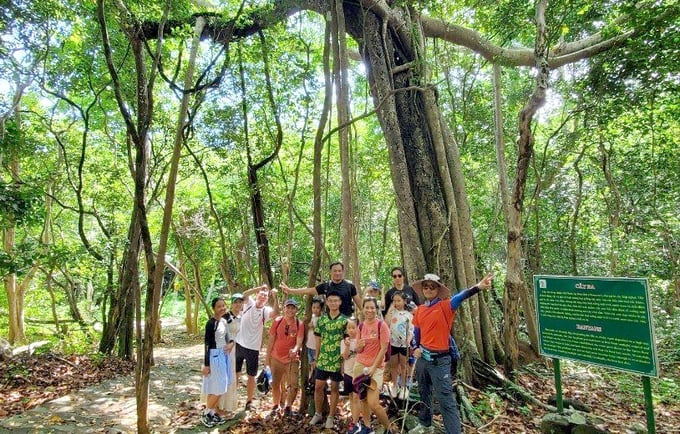November 26, 2025 | 06:17 GMT +7
November 26, 2025 | 06:17 GMT +7
Hotline: 0913.378.918
November 26, 2025 | 06:17 GMT +7
Hotline: 0913.378.918

An ancient tree in Cat Tien National Park. Photo: Son Trang.
Ms. Vo Thi Bich Thuy, Business Director of Tam An Group, is an entrepreneur with extensive experience in ecotourism. She believes that Cat Tien National Park has substantial potential for ecotourism development. The park's location, which is situated between two major tourist centers—Ho Chi Minh City and Da Lat—makes it simple to attract visitors from Da Lat or Ho Chi Minh City, particularly on weekends, in addition to its valuable natural resources.
Nevertheless, to effectively promote ecotourism in Cat Tien National Park, it is imperative to employ innovative and practical strategies.
For example, Tam Anh Group will evaluate "push" and "pull" factors when developing ecotourism excursions to Cat Tien National Park. "Pull" factors are the factors that will entice visitors to Cat Tien National Park at that particular time. Tourists' motivations to depart their residences in search of novel experiences are called "push" factors. When these two streams of information intersect, ecotourism professionals can create and improve tourism products that cater to visitors' unique requirements.
To fully capitalize on the immense natural potential of national parks and reserves, such as Cat Tien National Park, the development of ecotourism tours necessitates the application of creativity to provide visitors with various products within the same route and space.

Tourists participating in ecotourism at a reserve. Photo: Tran Phi.
Integrating teachings regarding the conservation of natural resources and forests is a critical component of ecotourism. When designing these lessons, the age categories of various tourist groups should be taken into account. It is also necessary to employ creativity to facilitate tourists' comprehension and retention of this information.
For instance, if the guide simply instructs tourists not to pick this leaf or capture that fish while leading them into the forest, it may cause many to feel uneasy and question the purpose of participating in a tour that is characterized by a multitude of restrictions.
Alternatively, the guide may inform travelers that the leaf they are about to remove is a food source for a herbivorous animal. In turn, this animal serves as a sustenance source for specific predators. Therefore, the natural food chain is inadvertently disrupted when forest leaves are removed. Tourists will comprehend the rationale behind refraining from arbitrary leaf plucking or fish catching during their visits to national parks and reserves with the assistance of this explanation. Consequently, tourists will experience a sense of pride in their contribution to the conservation of nature and biodiversity by refraining from causing damage to forest resources.
Tam Anh Group recently recommended that guides introduce lessons on forest and natural resource conservation in the manner described above during the organization of an ecotourism program at Bidoup – Nui Ba National Park. This suggestion was well-received by tourists.
To accommodate tourists' diverse ecotourism requirements, Ms. Thuy believes that Cat Tiên National Park and nearby national parks and reserves, including Bidoup—Nui Ba and Nui Chua, can establish a circular route that will alternately welcome tourists throughout the year and share the tourist market with Ho Chi Minh City, Nha Trang, Da Nang, Da Lat, and other locations.
Translated by Linh Linh

(VAN) Deputy Minister Nguyen Quoc Tri emphasized the determination to prevent violations at CoP20, sharing enforcement results and commitments to strengthen cooperation with the international community in the coming period.

(VAN) In addition to strengthening the relationship between schools and enterprises, the Aus4Skills project expands opportunities for female students and people with disabilities to work in the transport and logistics sector.

(VAN) Nghe An is preparing policy, technical, and resource steps to participate in the forest carbon credit market.
/2025/11/25/1648-2-110733_532.jpg)
(VAN) From 2011 to 2023, Ca Mau province lost approximately 6,200 ha of coastal land and protection forests due to erosion, threatening many residential areas, infrastructure facilities, and production zones.

(VAN) Quang Ngai holds strong potential for carbon credits but needs a clear legal and policy framework to secure sustainable revenue from this resource.

(VAN) With its diverse ecosystem, Phu Quoc National Park plays a vital role in environmental protection and biodiversity conservation and serves as the core zone of the Kien Giang World Biosphere Reserve.

(VAN) Cooperation activities under the Aus4Skills program focus on: logistics professional development, competency-based training and assessment (CBTA), leadership innovation, and digitalization.